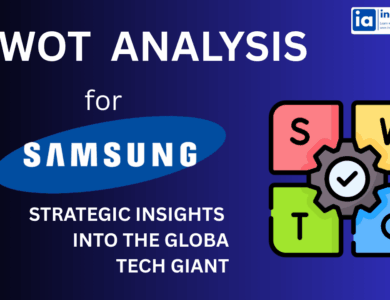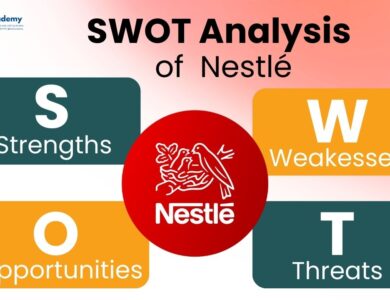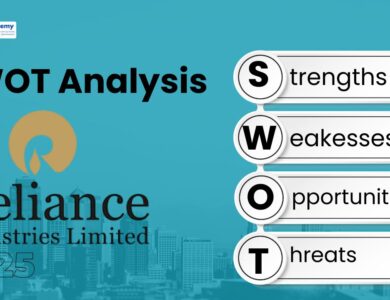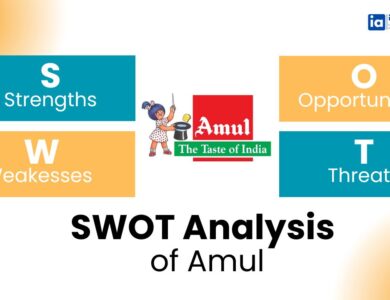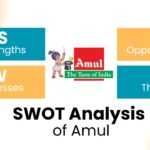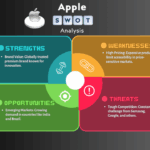SWOT Analysis of Hindustan Unilever Limited (HUL) – India’s FMCG Powerhouse in 2025
Explore the complete SWOT analysis of Hindustan Unilever (HUL) in 2025. Understand its core strengths, internal challenges, future opportunities, and market threats as India’s leading FMCG company.
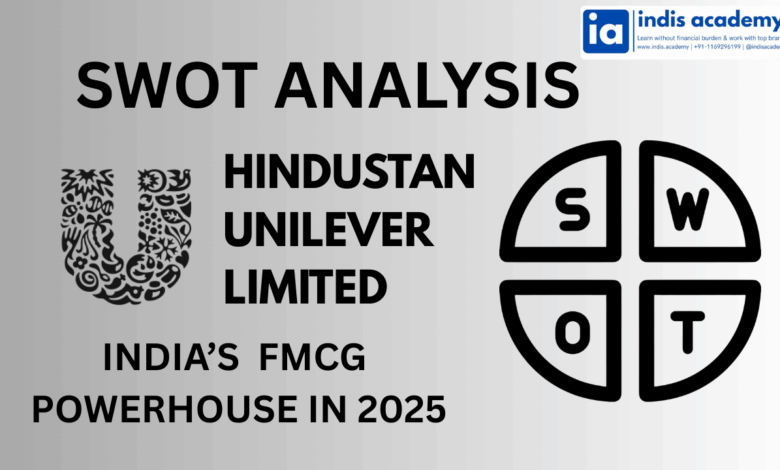
When you walk into any Indian home, chances are you’ll find at least one product from Hindustan Unilever Limited (HUL). Be it Lifebuoy soap, Surf Excel detergent, or Horlicks health drink, HUL has become a trusted part of everyday Indian life.
But in 2025, the FMCG landscape is evolving faster than ever.
With direct-to-consumer brands on the rise, consumers demanding sustainability, and rural markets going digital, even a market leader like HUL must adapt quickly. That’s where a SWOT analysis becomes essential—helping us assess how well HUL is positioned for the next decade.
In this blog, we’ll break down the Strengths, Weaknesses, Opportunities, and Threats of HUL to understand what’s powering its dominance—and what could disrupt it.
Let’s begin with a quick overview of the company behind India’s most loved brands.
Company Overview of Hindustan Unilever Limited (HUL)
Hindustan Unilever Limited (HUL) is India’s largest fast-moving consumer goods (FMCG) company and a subsidiary of the UK-based Unilever. Established in 1933, HUL has built a massive presence across urban and rural India, offering essential products in home care, beauty, hygiene, nutrition, and personal care.
As of 2025:
- Headquarters: Mumbai, Maharashtra
- Revenue: ₹60,000+ crore (FY24–25 estimate)
- Employees: 21,000+
- Brands: 50+ across 16 consumer categories
- Distribution reach: 9 million+ retail outlets across India
Popular Brands:
- Home Care: Surf Excel, Vim, Rin, Domex
- Personal Care: Dove, Lux, Lifebuoy, Pond’s, Sunsilk
- Nutrition & Health: Horlicks, Boost, Kissan
- Beauty & Grooming: Lakmé, Pepsodent, Close-Up, Axe
HUL’s strength lies in its ability to build trust at scale, backed by strong R&D, advertising, and an unbeatable distribution network that reaches deep into the Indian heartland.
What is a SWOT Analysis?
A SWOT analysis is a strategic framework used to evaluate a company’s current position by assessing four key dimensions:
- Strengths – What the company does well internally
- Weaknesses – Where it falls short or faces internal challenges
- Opportunities – External trends or changes the company can leverage
- Threats – External risks that could impact its business
For a legacy FMCG player like Hindustan Unilever (HUL), this analysis is especially useful in 2025.
Why? Because while HUL enjoys unmatched brand recognition, it now faces agile D2C competitors, sustainability shifts, and digitally empowered consumers—all of which demand quick adaptation and sharp strategy.
Understanding HUL’s SWOT helps us see how it’s balancing legacy power with future potential.
Strengths of HUL
HUL isn’t just a company—it’s a part of daily life for millions of Indian households. Its unmatched brand equity, product reach, and supply chain muscle make it a formidable force in the FMCG space.
Let’s break down the key strengths powering HUL’s dominance in 2025:
1. Massive Brand Portfolio with High Recall
With over 50 brands across 16 categories, HUL covers everything from detergents and soaps to tea and health drinks. Many of these brands—like Lifebuoy, Surf Excel, Lux, Dove, and Horlicks—are household names trusted across generations.
2. Deep Urban + Rural Penetration
HUL reaches over 9 million retail outlets in India, including kirana stores, wholesalers, and modern trade channels. Its rural network is one of the strongest in the industry, supported by mobile stockists, rural women entrepreneurs (Shakti Ammas), and last-mile innovations.
3. Strong Parent Company: Unilever PLC
As a subsidiary of global FMCG giant Unilever, HUL benefits from world-class R&D, global sourcing, digital transformation initiatives, and ESG leadership. This backing gives it a strategic edge over most local competitors.
4. Leadership in Key Categories
HUL is the #1 or #2 player in most of the categories it operates in, including:
- Detergents (Surf Excel, Rin)
- Soaps (Lifebuoy, Lux)
- Tea (Brooke Bond Red Label, Taj Mahal)
- Skincare (Pond’s, Vaseline)
- Oral care (Pepsodent, Close-Up)
5. Efficient Supply Chain & Marketing Engine
With decades of experience in mass advertising, rural sampling, and influencer-driven campaigns, HUL executes product launches and awareness campaigns at scale—something few competitors can match.
Competitor Comparison Table – 2025 Snapshot
| Company | FY25 Revenue (INR Cr) | # of Brands | Rural Reach | Parent/Backing |
|---|---|---|---|---|
| HUL | ₹60,000+ | 50+ | Very strong | Unilever (UK) |
| ITC FMCG | ₹20,000+ | 25+ | Growing fast | ITC Group |
| Nestlé India | ₹20,000+ | 10–15 | Moderate | Nestlé Global (Swiss) |
| Dabur | ₹12,000+ | 20+ | Strong in Ayurveda | Independent (India) |
Data based on industry reports and FY24–25 estimates.
HUL’s strengths stem from its ability to serve every Indian consumer segment—urban to rural, premium to mass—at scale, while constantly reinforcing trust and familiarity.
Weaknesses of HUL
Despite its dominance, Hindustan Unilever isn’t without vulnerabilities. In a world that’s shifting towards digital-first, value-driven, and purpose-led consumption, HUL’s scale sometimes becomes its limitation.
Let’s examine the key internal challenges HUL faces in 2025:
1. Premium Pricing in a Price-Sensitive Market
Many of HUL’s products—especially in skincare, personal care, and nutrition—are priced at a premium. In rural areas and inflation-impacted segments, this may push consumers toward affordable regional or D2C alternatives.
2. Overdependence on Legacy Brands
Brands like Lifebuoy, Lux, and Pond’s are decades old. While still profitable, HUL has not aggressively built millennial-first or Gen Z-focused brands at the same pace as new-age D2C competitors.
3. Slow D2C and E-commerce Evolution
HUL still depends heavily on traditional retail and distribution. In comparison, competitors and startups are growing fast through direct-to-consumer websites, influencer marketing, and Instagram-native brands.
4. Vulnerability to Raw Material Inflation
Core inputs like palm oil, crude-based ingredients, and packaging materials are subject to global price fluctuations. This directly impacts margins, especially in soaps, detergents, and food.
5. Global Alignment May Delay Local Innovation
As a Unilever subsidiary, HUL often has to align with global innovation cycles and sustainability frameworks—which may not always sync with hyper-local Indian consumer demands or speed to market.
These weaknesses don’t shake HUL’s foundation—but they point to areas where greater agility, affordability, and digital adoption will be key to staying ahead.
Opportunities for HUL
HUL sits at the intersection of legacy power and modern potential. With India’s FMCG market evolving rapidly, 2025 presents several high-impact opportunities for HUL to expand, adapt, and lead.
Let’s explore the most promising growth avenues:
1. Rising Demand for Natural, Ayurvedic & Clean-Label Products
Consumers are increasingly moving towards chemical-free, ayurvedic, and sustainable products. HUL can grow in this space by:
- Expanding its Ayush brand
- Acquiring clean-label D2C startups
- Competing with Patanjali, Dabur, and Mamaearth in the natural segment
2. Digital-First, D2C and E-Commerce Channels
HUL has the scale to build category-specific D2C platforms in skincare, baby care, and wellness. It can also accelerate:
- Personalization via AI-driven commerce
- Subscription models (e.g., for nutrition or hygiene)
- Influencer-led brand launches for Gen Z
3. Rural Growth through Digitization & Mobile Penetration
With more rural consumers coming online, HUL can boost market share by:
- Launching vernacular content and mobile-first campaigns
- Building WhatsApp commerce or voice-based ordering
- Leveraging UPI and digital coupons for promotions
4. Sustainability & ESG-Driven Branding
HUL’s parent company is a global leader in sustainability. By aligning Indian operations with plastic reduction, water conservation, and carbon neutrality goals, HUL can strengthen brand trust with eco-conscious consumers.
5. Health, Hygiene & Nutrition Post-COVID
Post-pandemic awareness has shifted focus to personal hygiene and immunity. HUL’s brands like Horlicks, Boost, Lifebuoy, and Domex are well-positioned to dominate this health-conscious wave.
If HUL accelerates these opportunities with speed, innovation, and local flavor, it can secure its leadership for another generation.
Threats to HUL
Even giants can be shaken—especially in a market as dynamic and competitive as India’s FMCG space. While HUL is deeply entrenched, several external threats could challenge its dominance in the years ahead.
Let’s take a look at the most pressing risks:
1. Rising Competition from Indian FMCG Players
Brands like ITC, Dabur, Patanjali, and Emami are expanding aggressively into HUL’s core segments, especially with natural and ayurvedic products. Their pricing and nationalist branding appeal strongly to rural and value-conscious consumers.
2. D2C Startups Eating into Niche Categories
Direct-to-consumer brands like Mamaearth, WOW Skin Science, The Moms Co., and Plum are rapidly capturing online-first, Gen Z audiences in beauty, baby care, and wellness—segments where HUL lags in innovation speed.
3. Regulatory Pressures on Sustainability & Packaging
With stricter norms around plastic packaging, greenwashing claims, and environmental disclosures, HUL must balance profitability with compliance, especially in categories like sachets and single-use products.
4. Input Cost Inflation & Supply Chain Shocks
Volatility in raw material prices—like palm oil, crude derivatives, and milk—along with supply chain disruptions (fuel prices, transport strikes) can strain margins across product lines.
5. Evolving Consumer Loyalty Among Youth
Gen Z and urban millennials are more experience-driven, socially aware, and open to trying new brands. This shift in mindset can weaken HUL’s traditional hold unless it modernizes storytelling and product formats.
While these threats don’t yet threaten HUL’s survival, they do challenge its agility, innovation velocity, and ability to retain relevance among next-gen consumers.
Strategic Insights & Key Takeaways
HUL in 2025 is more than just a market leader—it’s a brand ecosystem that has shaped how India eats, cleans, washes, and cares. But the playbook that made it dominant needs updating for a digital, conscious, and experience-driven world.
Here’s what this SWOT analysis reveals:
- Strengths like brand trust, distribution depth, and global backing keep HUL ahead of the curve.
- But weaknesses in innovation speed, premium pricing, and digital maturity show cracks that competitors are exploiting.
- Opportunities in D2C, wellness, sustainability, and vernacular marketing offer strong future growth—if HUL pivots quickly.
- Yet, threats from agile D2C brands, input inflation, and shifting consumer values will continue to test its adaptability.
To maintain leadership, HUL must modernize faster, act bolder, and build new-age trust with new-age consumers.
Conclusion
Hindustan Unilever Limited isn’t just India’s biggest FMCG brand—it’s a symbol of consistency, trust, and mass-scale impact. For decades, it has shaped consumer behavior across generations and geographies.
But 2025 is not business as usual.
As digital-first brands disrupt legacy playbooks and sustainability becomes more than a buzzword, HUL must go beyond distribution muscle. It must become faster, cleaner, more personalized, and above all—more digitally intimate with its next generation of consumers.
The SWOT analysis makes one thing clear: HUL has all the tools to win. Now, it must choose speed over size and agility over legacy to shape the next era of FMCG in India.
❓ FAQs – SWOT Analysis of Hindustan Unilever Limited (HUL)
1. What makes HUL a market leader in India?
HUL leads due to its diverse brand portfolio, massive retail presence, strong brand recall, and support from global parent Unilever.
2. What are HUL’s most profitable product categories?
Personal care (soaps, skincare), home care (detergents), and nutrition (Horlicks, Boost) are among HUL’s top-performing categories.
3. How is HUL adapting to digital trends?
HUL is gradually investing in D2C brands, influencer campaigns, AI-led marketing, and expanding its e-commerce presence, but is still catching up to agile startups.
4. What are HUL’s main competitors in 2025?
ITC, Dabur, Patanjali, Nestlé India, Emami, and new-age D2C brands like Mamaearth, WOW Skin Science, and Plum.
5. Is HUL focusing on sustainability?
Yes. HUL is aligning with Unilever’s global ESG goals, including plastic reduction, water positivity, sustainable sourcing, and carbon neutrality by 2039.
